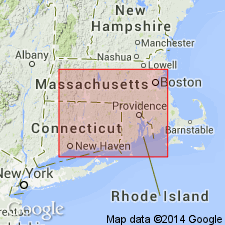
- Usage in publication:
-
- Scituate Granite Gneiss*
- Modifications:
-
- Age modified
- AAPG geologic province:
-
- New England province
Summary:
Age changed from Mississippian(?) or older to Proterozoic Z based on isotopic dating and relationships with other granitic bodies. Radiometric ages of the Sterling Plutonic Group rocks and other granitic rocks from the Avalon terrane, determined by various methods, range from about 650 to 600 m.y. (Zartman and Naylor, 1972; Nelson, 1975; Day, 1968; Hills and Dasch, 1972; R.E. Zartman and R.S. Naylor, unpub data, 1978). A 569 +/-4 m.y. age by Rb-Sr methods on Northbridge Granite Gneiss (now considered to be equivalent to Scituate Granite Gneiss and Ponaganset Gneiss) in northern part of Rhode Island batholith (Fairbairn and others, 1967) is close to the Proterozoic Z-Cambrian boundary; this is uncomfortably close considering unconformity at Hoppin Hill, MA. Day (1969) obtained an Rb-Sr age of 638 +/-42 m.y. on Scituate Granite Gneiss and other granite gneisses elsewhere in the batholith. An Early Cambrian age cannot be ruled out. Considered to be approximately equivalent to Potter Hill Granite Gneiss, which is newly assigned to Sterling Plutonic Group. Sterling plutons now thought to be intruded in this order: Ponaganset Gneiss (oldest), Potter Hill Granite Gneiss (approx. = Scituate Granite Gneiss), Ten Rod Granite Gneiss (not mapped in New London area), and Hope Valley Alaskite Gneiss (youngest). Age assignments of all units changed to Proterozoic Z.
Source: GNU records (USGS DDS-6; Reston GNULEX).
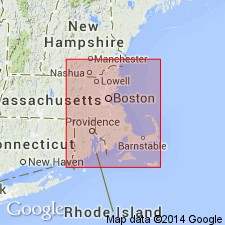
- Usage in publication:
-
- Scituate Granite Gneiss*
- Modifications:
-
- Areal extent
- Age modified
- AAPG geologic province:
-
- New England province
Summary:
Scituate Granite Gneiss of Quinn (1951) is Proterozoic Z based on radiometric age determinations by Day and others (1980) and R.E. Zartman and R.S. Naylor (1978, written commun.). Hermes and others (1981), however, have shown that rock mapped as Scituate in RI is Devonian. Scituate, like Hope Valley Alaskite Gneiss and Ponaganset Gneiss, extends into MA in Rhode Island batholith.
Source: GNU records (USGS DDS-6; Reston GNULEX).

- Usage in publication:
-
- Scituate Granite*
- Modifications:
-
- Overview
- AAPG geologic province:
-
- New England province
Summary:
Used as Scituate Granite of Proterozoic Z age. Occurs in southeastern MA and adjacent RI. Equivalent to part of former Northbridge Granite Gneiss (usage now abandoned). Gradational with Hope Valley Alaskite Gneiss.
Source: GNU records (USGS DDS-6; Reston GNULEX).
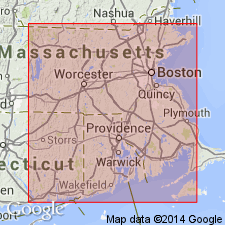
- Usage in publication:
-
- Scituate Plutonic Suite
- Modifications:
-
- Revised
- AAPG geologic province:
-
- New England province
Summary:
Authors refer to the Scituate and East Greenwich plutonic rocks collectively as the Scituate Plutonic Suite. Authors suggest that the Spencer Hill Volcanics may be coeval with the Devonian Scituate, but no radiometric ages are available to confirm association.
Source: GNU records (USGS DDS-6; Reston GNULEX).
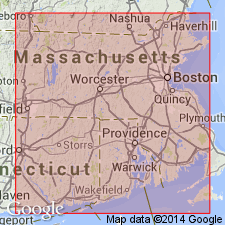
- Usage in publication:
-
- Scituate Plutonic Suite, Supersuite
- Modifications:
-
- Revised
- AAPG geologic province:
-
- New England province
Summary:
Devonian alkalic intrusions, including the well known Scituate Granite, are here grouped under the term Scituate Plutonic Supersuite. Includes all of the recognized Devonian units of alkaline affinity in RI. These are the Scituate Plutonic Suite, the East Greenwich Plutonic Suite, and the Rhode Island Quincy Granite. These alkalic intrusions have an areal extent of 700 square km. The Scituate Plutonic Suite [also called Scituate Granite] consists predominantly of slightly foliated and lineated rocks, though massive and porphyritic rocks are common. Intrudes rocks of the Blackstone Group and the Esmond Granite. Scituate and East Greenwich Plutonic Suites appear to be a cogenetic igneous complex based on similar age and mineral assemblages. [The usages of Scituate in this report are not recommended. According to Article 41 of the NASC, "the geographic name of a suite may not be the same as that of a component lithodeme. Intrusive assemblages, however, may share the same geographic name if an intrusive lithodeme is representative of the suite."]
Source: GNU records (USGS DDS-6; Reston GNULEX).
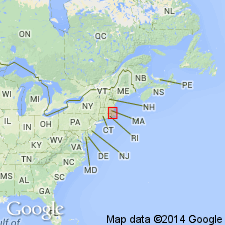
- Usage in publication:
-
- Scituate Granite*
- Modifications:
-
- Revised
- Areal extent
- Age modified
- Geochronologic dating
- AAPG geologic province:
-
- New England province
Summary:
Scituate as shown on MA State Geologic Map (Zen and others, 1983) forms elongate masses in northwestern RI and MA. The name Scituate Granite Gneiss is no longer appropriate because the type Scituate of Quinn (1971) at Scituate, RI, has been shown by Hermes and others (1981) and Hermes and Zartman (1985) to be Middle Devonian, based on isotopic age of 373 +/-7 Ma; it is part of an unnamed Devonian alkalic suite. Scituate of type area in central RI described by Quinn (1971) is here renamed Scituate Granite and assigned a Middle Devonian age. Area of Scituate Granite coincides with main mass as shown by Quinn (1971) with minor adjustment of boundaries (O.D. Hermes and Peter Gromet, oral commun., 1984). Scituate Granite as shown on MA State Geologic Map contains roof pendants of Plainfield Formation and is Proterozoic Z in age. Isotopic date of 630 +/-15 Ma, using U-Pb methods on zircon, was obtained for the rock in MA by Zartman and Naylor (1984) and supports this designation. Therefore, Middle Devonian Scituate Granite is not present in MA. Authors suggest reviving Emerson's old name, Northbridge Gneiss, for this unit, although detailed mapping may reveal that several types of distinct granites are present. Report includes geologic maps [Papers presented as chapters in U.S. Geological Survey Professional Paper 1366 are intended as explanations and (or) revisions to MA State bedrock geologic map of Zen and others (1983) at scale of 1:250,000.]
Source: GNU records (USGS DDS-6; Reston GNULEX).
For more information, please contact Nancy Stamm, Geologic Names Committee Secretary.
Asterisk (*) indicates published by U.S. Geological Survey authors.
"No current usage" (†) implies that a name has been abandoned or has fallen into disuse. Former usage and, if known, replacement name given in parentheses ( ).
Slash (/) indicates name conflicts with nomenclatural guidelines (CSN, 1933; ACSN, 1961, 1970; NACSN, 1983, 2005, 2021). May be explained within brackets ([ ]).

